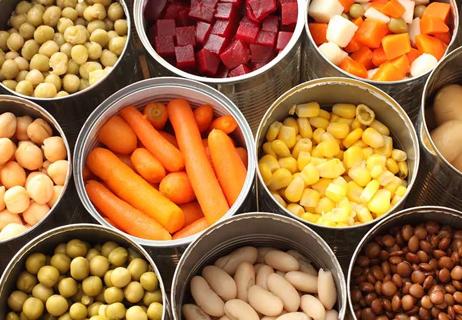Microwaves use non-ionizing radiation and haven’t been shown to cause cancer — follow food safety practices and use microwave-safe containers

A microwave oven is a staple in many households. It’s such a convenient little contraption to heat up food and drinks quickly and effectively.
Advertisement
Cleveland Clinic is a non-profit academic medical center. Advertising on our site helps support our mission. We do not endorse non-Cleveland Clinic products or services. Policy
But some people worry about their safety.
What’s the truth? Are microwaves bad for you? Do they cause cancer? Can you microwave plastic? Why did your parents always yell at you for standing in front of the microwave?
We talked with registered dietitian Paige Welsh, RD, LD, to separate fact from fiction, so you can microwave with confidence.
Microwaves use radiation to cook food. And that can sound awfully scary.
“When you look up how microwaves work, you’re going to see the term ‘radiation.’ People hear that, and instantly, it sounds scary. They’re taken aback by that term,” Welsh acknowledges. “But what a lot of people don't realize is there are different types of radiation that carry different risks with them.”
Microwaves use non-ionizing radiation to heat up food. That’s the same kind of radiation found in cell phones, TVs, light bulbs and other common household items.
Ionizing radiation is the kind that’s more often associated with a slightly increased risk for cancer. That’s used in things like X-rays and CT scans.
Ionizing radiation can change atoms. It does this by removing an electron, which can create unstable ions. With enough exposure, those ionized atoms can cause cell damage and, potentially, cancer. (Though it takes A LOT of radiation to cause cancer. So, it’s not typically a worry for most people who need the occasional X-ray or CT scan.)
Advertisement
Non-ionizing radiation, as used in microwaves, doesn’t change molecular makeup.
The National Cancer Institute says that most types of non-ionizing radiation haven’t been found to cause cancer. And the American Cancer Society says, “When microwave ovens are used according to instructions, there is no evidence that they pose a health risk.”
Even without the worries about cancer, microwave use can pose some other safety hazards that deserve your consideration.
Welsh shares some tips for safe microwaving.
Part of what makes microwaves safe appliances for heating up your food is that they’re heavily regulated. The U.S. Food and Drug Administration (FDA) has regulated microwave manufacturers since the 1970s.
“There are very specific standards that determine how much leakage is allowed to come out of the microwave,” Welsh shares. “What is allowed is significantly below any level that would cause any type of damage.”
But there’s a catch.
Those standards are based on well-functioning machines that are in tip-top shape. And any damage to your microwave can compromise its safety.
Damage can allow some of that non-ionizing radiation to escape. And high amounts of non-ionizing radiation can cause burns and damage your eyes.
Don’t use a microwave if it’s:
“Damage can cause leakage. And while it would take a very high amount of exposure for you to notice any negative impacts, it’s not worth taking any risks,” Welsh warns.
You probably heard warnings about staying away from a microwave when it’s in use. The reason goes back to the fear of radiation leaking from the machine.
But if your microwave is in good shape, the risk should be very minimal. (Remember those thorough regulation standards.)
“If you have a well-functioning microwave, you shouldn’t be at risk. But standing away is an extra step you can take to further ensure your safety,” Welsh advises.
Standing farther from the machine can decrease your potential for exposure because any teeny bit of radiation that comes out of the microwave mixes with the air around it, essentially diluting it.
When choosing containers to microwave your food in, some plastics should be avoided. Typically, if your plastic bowls, plates and containers say they’re microwave-safe, they’re good to go. Otherwise, keep them out of the microwave.
Advertisement
“Plastic wrap and plastic containers that aren’t microwave-safe can melt into your food, and we don’t want to be eating bits of plastic,” Welsh cautions.
But some people will tell you that all plastic containers should be avoided in the microwave because they can potentially leak harmful molecules into your food.
Welsh’s take? “We do know that those plastics degrade faster if they’re not approved for the microwave, but it’s not clear exactly what impact that has on our health. We need more research to know for sure.”
If you’re concerned about the potential effects of microwaved plastic, there’s no harm in avoiding it and opting instead for microwave-safe materials, like glass or ceramic.
The risk of metal containers, silverware and aluminum foil in the microwave is well-documented by social media pranksters. Namely: sparks and fire.
And while a microwave fire is a clear danger on its own, it’s not only the initial flame that’s cause for concern.
“Microwaves use a specific type of metal plate to help prevent radiation leakage,” Welsh explains. “When you put metal in the microwave and it sparks, it can compromise the integrity of that metal plate that keeps us safe.”
When you reheat that casserole or soup in the microwave, it’s more than a matter of heating food to make it more palatable. What’s also important is making sure your food is thoroughly heated to kill off bacteria.
Advertisement
“We want to make sure our leftovers are getting up to a properly high temperature,” Welsh shares. “After our food is initially cooked, there’s always a risk of it becoming contaminated. So, you want to make sure your microwaved food is hot enough to be safe.”
The magic temperature? 165 degrees Fahrenheit (74 degrees Celsius).
Pro tip: Microwaves heat food from the outside in. So, your food is likely to be warmer on the outside than on the inside. Cut your leftovers into smaller pieces to help ensure they heat up consistently. Stir your soup before testing the temperature to make sure it’s thoroughly heated.
When it comes to things like steaming veggies, it turns out that microwaves can be highly efficient and effective.
“When you boil vegetables, you can lose some of the nutrients because the water steals some of the vitamins and minerals,” Welsh points out. “But in the microwave, you don’t have that problem. Microwaves can help to preserve nutrients in our food more than a lot of other cooking methods.”
And consider the timing. If you roast veggies in the oven, that’s more time in high heat, which breaks down some nutrients in your food. In the microwave, those nutrients aren’t affected as much because they don’t cook nearly as long.
Advertisement
On the other hand, many other microwaveable foods aren’t the nutritional powerhouses your body deserves. While not the fault of the microwave itself, microwaveable meals typically aren’t whole foods. And they’re notoriously high in sodium. So, be thoughtful that you’re not relying on packaged microwavable foods as a staple in your diet.
Microwaves aren’t inherently bad for you. But using them safely is important. So, use your microwave properly to best enjoy its convenience and other benefits.
Learn more about our editorial process.
Advertisement

Leftovers can be kept in the fridge for three to four days or frozen for three to four months

Ultimately, rice is safe to eat, but the type, where it’s grown and how you cook it may be factors to consider

Washing your hands, thoroughly cleaning kitchen tools and preparing meat separately can reduce the risk of foodborne illness

Extended outages lasting more than four hours can make food in your fridge unsafe to eat

Once perishable food hits the table, it’s typically good for about two hours

Color, texture, smell and expiration date all hold important clues

No! Be sure to put your leftovers in the fridge

Not all processed foods are bad, but the fewer the ingredients, the better

Babies can get congested easily, but you can calm their cough by keeping them hydrated, using nasal drops and running a humidifier

Weight loss may cause loose, sagging skin and muscle loss to your rear

Several conditions, like vitiligo and fungal infection, can cause a loss of pigmentation, leading to white spots or patches on your skin